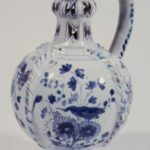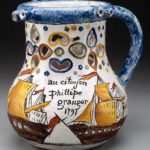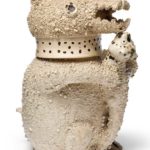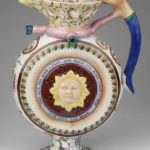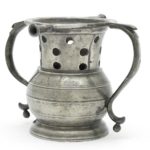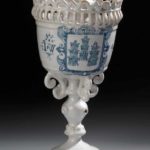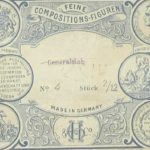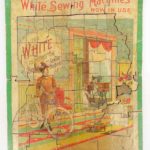Puzzle jugs are puzzles in the form of a jug and were popular in the 18th and 19th centuries. Puzzle jugs of varying quality were popular in homes and taverns. An inscription typically challenges the drinker to consume the contents without spilling them, which, because the neck of the jug is perforated, is impossible to do conventionally.
The solution to the puzzle is that the jug has a hidden tube, one end of which is the spout. The tube usually runs around the rim and then down the handle, with its other opening inside the jug and near the bottom. To solve the puzzle, the drinker must suck from the spout end of the tube. To make the puzzle more interesting, it was common to provide a number of additional holes along the tube, which must be closed off before the contents could be sucked. Some jugs even have a hidden hole to make the challenge still more confounding. Reference: Wikipedia
Below are some examples and price guides of puzzle jugs including a tin-glazed earthenware jug dated 1689 and a rare Staffordshire white stoneware bear shaped puzzle jug.
Tin-glazed earthenware (delftware) puzzle jug dated 1689 British, Lambeth
Reference: The Metropolitan Museum of ArtPuzzle Jug French (Nevers) Dated 1791
Decorated with three ships in yellow, brown, blue, red and black; on the neck are perforated designs edged with green, yellow, blue and brown, surrounded by rosettes in blue, yellow and green; blue rim and handle; with painted legends Anselme Gíroux de Nevers, 1791 and au Citoyen Phillipe Granger, 1791.
Reference: Museum of Fine Arts Boston
A RARE STAFFORDSHIRE WHITE SALT-GLAZED STONEWARE BEAR PUZZLE JUG AND COVER CIRCA 1745-50 modeled seated holding a dog between its paws forming the concealed spout, the neck and the underside of the arms pierced, its fur formed from shredded clay picked out with dots of brown slip. height 9 1/8 in. 23 cm
Salt-glaze bear jugs of this type are relatively uncommon, but it is exceptionally rare to find an example adapted as a puzzle jug.
Sold for 8,125 USD at Sotheby’s in 2019
Puzzle jug of lead-glazed earthenware, transfer-printed in black outline, painted in colours. Flattened circular body moulded on either side with a sun-face, round which are painted Chinoiserie figures, animals, vases and flowers. One face is surrounded by the inscription ‘GOD SAVE THE KING, I PRAY GOD BLESS THE KING, I SAY 1775 GOD SAVE THE KING.’ The spreading perforated mouth and the high foot are marbled; the loop handle in the from of a merman is connected by a tube with the neck from which project three spouts.
Reference: © Victoria and Albert Museum
AN EXTREMELY RARE VICTORIAN PEWTER PUZZLE-JUG, PROBABLY BRISTOL, CIRCA 1840-60 The flared neck with several large pierced holes, the squat bulbous body with three narrow fillets and engraved to both sides – Who can drink, may / Who can’t drink, pay – the rim with two spouts, the twin-handles with thumb-rest flange and ‘tear-drop’ terminal, apparently unmarked, 22cm wide x 16.5cm high
Sold for £ 956 inc. premium at Bonham’s in 2019
Puzzle wine goblet; tin-glazed earthenware; bowl with pierced rim; elaborate stem with scroll supports below bowl; openwork decoration near rim; domed foot; elaborate syphon in centre; painted in blue with arms of Drapers’ Company; inscribed initials and date.
© The Trustees of the British Museum
[1] Wikipedia
